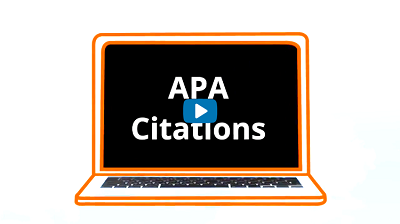APA (American Psychological Association) style is most commonly used to cite sources within the health and social sciences disciplines. The following examples use APA 7th edition.

Tutorial: APA 7th Edition Citation Style
Pause or complete the video before closing. Otherwise it will keep playing.
An in-text citation is a brief mention within the body of your paper that leads the reader to the complete information about that reference. It usually appears at the end of a sentence. In-text citations include the author of the source (often in a signal phrase), the year of publication, and, if it is a direct quote, the page number in parentheses.
Sabin (2022) observed that “no interventions for reducing implicit biases have been shown to have enduring effects” (p. 2409).
OR
Implicit bias reduction techniques are not effective in the long term (Sabin, 2022).
OR
Sabin (2022) found that there are no methods that reduce implicit bias in the long term.
In-text citations will lead readers to the reference list at the end of the paper. Every APA paper must include a list of references. References are listed in alphabetical order, using the author's last name (if there are multiple authors, follow the order provided in the source). Each reference citation will include the author's name, date of publication, title, publisher, and place of publication.
Electronic articles
Sabin, J. A. (2022). Tackling implicit bias in health care. The New England Journal of Medicine, 387(2), 105–107. https://doi.org/10.1056/NEJMp2201180
If the article does not have a DOI (digital object identifier) or other stable URL that will resolve for the reader, end the citation after the page range just like a print article.
Print articles
Adams, S. K., Mushkat, Z., & Minkel, J. (2022). Examining the moderator role of sleep quality in the relationship among test anxiety, academic success, and mood. Psychological Reports, 125(5), 2400-2415.
eBooks
Jackson, L. M. (2020). The psychology of prejudice: From attitudes to social action (2nd ed.). American Psychological Association. https://doi.org/10.1037/0000168-000
If the eBook does not have a DOI (digital object identifier) or other stable URL that will resolve for the reader, end the citation after the publisher just like a print book.
Print books
Kobabe, M. (2019). Gender queer: A memoir. Lion Forge, LLC.
Webpages with an individual author
Puckett, C. (2022, September 27). Eating seasonally and locally has many benefits. Is fighting the climate crisis one of them? CNN. https://www.cnn.com/2022/09/14/health/seasonal-food-produce-lbg-wellness/index.html
Webpages with a group or organizational author
Ben & Jerry's. (n.d.). Our history. https://www.benjerry.com/about-us
Webpages with a retrieval date
Retrieval dates are only required for webpages that change over time but are not archived.
U.S. Census Bureau. (n.d.). U.S. and world population clock. U.S. Department of Commerce. Retrieved October 21, 2022, from https://www.census.gov/popclock/
Films
Winans, J., Winans, K., & Muratore, R. (Directors). (2020). Childhood 2.0 [Film]. Filmhub, Inc.
YouTube Videos
CrashCourse. (2019, January 22). Check yourself with lateral reading: Crash Course Navigating Digital Information #3 [Video]. YouTube. https://www.youtube.com/watch?v=GoQG6Tin-1E
Artwork in a museum or on a museum website
Abeyta, T. (2015). The Grand Canyon [Painting]. The National Museum of the American Indian, Washington, DC, United States. https://americanindian.si.edu/collections-search/objects/NMAI_412304
Photograph (not associated with a museum)
O'Connor, K. Lily Hevesh prepares for the Brattleboro Museulm and Art Center's 15th annual Domino Toppling Extravaganza [Photograph]. VTDigger. https://vtdigger.org/2022/10/17/with-14-million-youtube-views-this-vermont-attraction-touts-the-ultimate-domino-effect/
This work is licensed under CC BY-NC-SA 4.0
